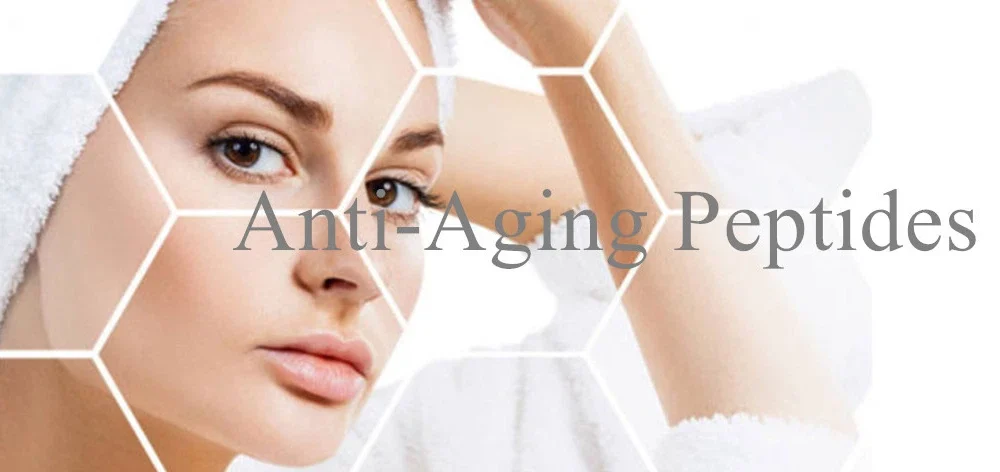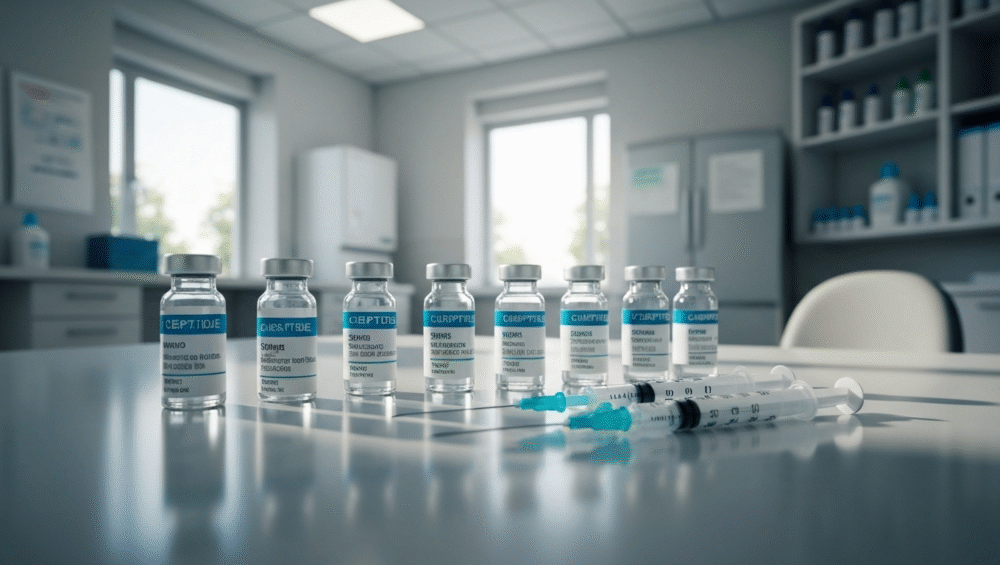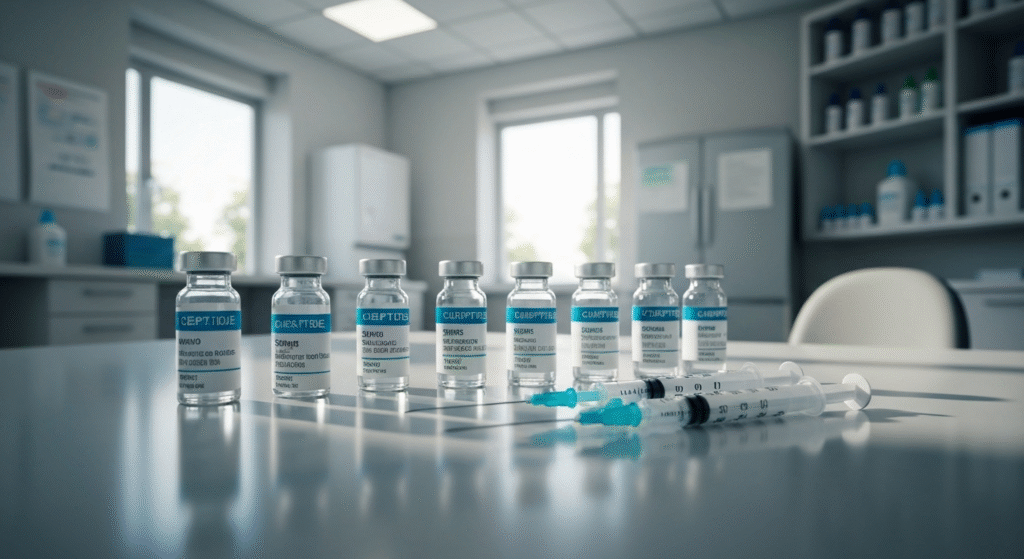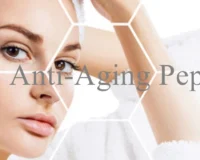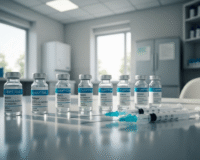Anti-Aging Peptides: Revolutionizing Skin Care in the USA
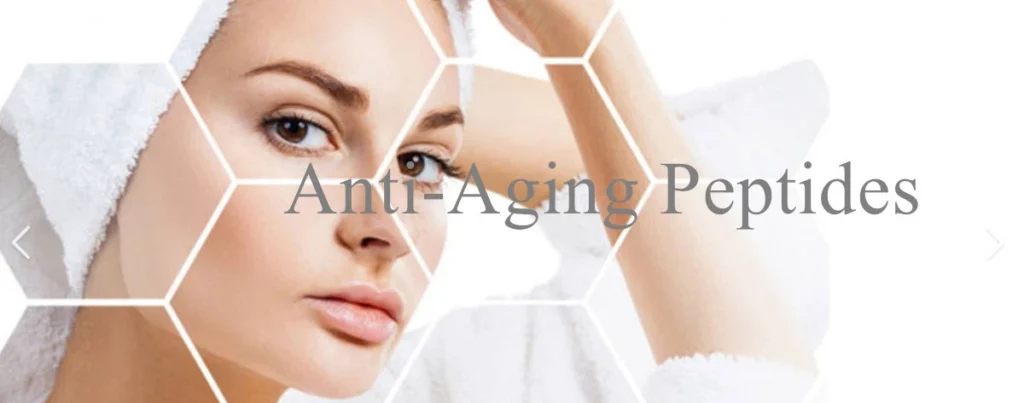
Anti-Aging Peptides
- Anti-aging peptides are short chains of amino acids that act as messengers for your skin cells. They effectively combat the visible signs of aging by boosting collagen synthesis. Peptide therapy helps improve skin elasticity and firmness for a more youthful look. If you’re looking for a comprehensive database on anti-aging peptides, resources such as scientific journals, PubChem, and cosmetic ingredient databases can provide detailed information on their types, mechanisms, and clinical studies. These databases often detail the roles of specific amino acid sequences in skin health and visible signs of aging.
- They effectively combat the visible signs of aging by boosting collagen synthesis. Peptide therapy helps improve skin elasticity and firmness for a more youthful look. Different peptides target specific concerns, from wrinkles to hydration. For those seeking detailed information on anti-aging peptides, several comprehensive databases and scientific resources are available online. Notable examples include PubMed, a database of biomedical literature, and clinical trial registries, which provide up-to-date research and clinical information on peptide therapy, their effects on collagen synthesis, skin elasticity, and various signs of aging.
- Peptide therapy helps improve skin elasticity and firmness for a more youthful look.
- Different peptides target specific concerns, from wrinkles to hydration.
- Integrating peptides into your routine can significantly enhance overall skin health and resilience.
- These powerful ingredients support the skin’s natural repair processes.
Anti-Aging Peptides
As skin aging becomes a more prominent concern, many are searching for effective solutions that go beyond surface-level treatments. Enter the world of peptides. These powerful building blocks are revolutionizing skincare by working at a cellular level to address the root causes of aging. By encouraging collagen production and supporting your skin’s natural functions, peptide therapy offers a science-backed path to a smoother, firmer, and more radiant complexion. Are you ready to unlock their potential?
Understanding Anti-Aging Peptides in Modern Skincare
Peptides are some of the most exciting active ingredients in modern skin care. They are small but mighty molecules that play a crucial role in maintaining your skin health. By signaling your skin cells to perform specific jobs, they help counteract the visible signs of aging and fortify the skin barrier.
Unlike harsher ingredients, peptides work by mimicking your body’s natural processes. This helps slow down the aging process and reverse some of the effects of aging by stimulating the production of collagen. The following sections will explore how these smart ingredients function.
What Are Anti-Aging Peptides and How Do They Work?
At their core, anti-aging peptides are short chains of amino acids, which are the fundamental building blocks of proteins in your skin like collagen and elastin. When these proteins break down due to skin aging or environmental factors, your skin’s firmness and elasticity suffer. This is where peptides step in to help.
Think of peptides as messengers. When applied to your skin, they send signals to your cells, instructing them to ramp up collagen synthesis. This targeted communication helps your skin rebuild and rejuvenate from within, making peptides a cornerstone of effective peptide therapy.
This process leads to tangible improvements. Increased collagen means plumper, firmer skin with reduced fine lines and wrinkles. By reinforcing your skin’s foundational structure, anti-aging peptides directly combat the key factors that contribute to a loss of youthful appearance and promote better skin elasticity.
The Science Behind Skin Peptides USA
The science supporting skin peptides available in the USA is robust and continues to grow. Each peptide is a specific sequence of an amino acid or multiple amino acids, designed to perform a distinct function once it reaches your skin cells. This specialization allows for targeted treatments for various aging concerns.
Researchers in the United States and globally have identified how certain peptides can instruct skin cells to boost collagen production, which is essential for maintaining youthful skin. Others are designed to deliver vital minerals or protect against oxidative stress, a major contributor to premature aging.
The future potential is immense. Current studies focus on improving how peptides penetrate the skin barrier to make them even more effective. As science advances, you can expect to see even more sophisticated peptide formulations that offer precise, powerful results for skin rejuvenation.
Why Are Peptides Essential for Youthful Skin Renewal?
Peptides are essential for youthful skin renewal because they support the skin’s natural regeneration abilities. As you age, the aging process slows down collagen synthesis, and your skin’s barrier weakens. Peptides work to counteract these changes directly.
Through peptide therapy, you can effectively tell your skin to behave as it did when it was younger. By stimulating collagen synthesis, peptides help restore the skin’s structure, making it firmer and smoother. This is a fundamental step in any effective anti-aging strategy.
Furthermore, a strong skin’s barrier is critical for overall skin health. Peptides help fortify this protective layer, enabling your skin to retain moisture better and defend itself against environmental aggressors like pollution and UV rays. This dual action of repair and protection makes peptides invaluable for maintaining a healthy, youthful glow.
Leading Types of Anti-Aging Peptides Used in U.S. Skincare
Not all peptides are created equal. The various types of peptides used in U.S. skin care are categorized based on their specific functions. Understanding these differences can help you choose peptide products with the right active ingredients for your unique concerns, from fine lines to loss of firmness.
These powerhouse molecules are designed to do everything from boosting collagen production to relaxing facial muscles. Let’s look at some of the most effective and popular types you’ll find in today’s advanced skincare formulations.
Signal Peptides and Their Role in Skin Rejuvenation
Signal peptides are arguably the most well-known type for skin rejuvenation. As their name suggests, they send signals to your skin cells, prompting them to produce more of the proteins that keep skin looking young, such as collagen and elastin.
When applied topically, these peptides essentially trick your skin into thinking it’s been injured or that its collagen has broken down, triggering a repair response. This kicks collagen synthesis into high gear, helping to rebuild the skin’s structure from the inside out. Peptides like Matrixyl (Palmitoyl Pentapeptide-4) are excellent examples of signal peptides.
The result is a noticeable improvement in skin elasticity and firmness. By promoting this natural rebuilding process, signal peptides help reduce the appearance of wrinkles and improve overall skin health, making them a key ingredient in the fight against aging.
Carrier Peptides for Enhanced Nutrient Absorption
Carrier peptides play a completely different but equally important role. Their primary function is to deliver essential trace minerals, such as copper and manganese, to your skin cells. These minerals are vital cofactors for enzymatic processes involved in wound healing and collagen synthesis.
Think of carrier peptides as a specialized delivery service for your skin. They stabilize and transport these minerals, ensuring they can be used effectively by the skin to support its natural functions. This process is crucial for maintaining a healthy skin barrier and promoting optimal skin health.
The most famous example is GHK-Cu, or copper peptides. These have been extensively studied for their ability to improve skin elasticity, reduce inflammation, and accelerate tissue repair. By enhancing nutrient absorption at a cellular level, carrier peptides help your skin function at its best.
Neurotransmitter Inhibitor Peptides to Smooth Expression Lines
If you’re concerned about expression lines, neurotransmitter inhibitor peptides are the solution you need. These peptides work by interfering with the communication between nerves and facial muscles, causing the muscles to relax. This mechanism is often compared to the effects of Botox, earning them the nickname “Botox in a bottle.”
By inhibiting the signals that cause muscle contractions, these peptides help soften the appearance of dynamic wrinkles like crow’s feet, forehead lines, and frown lines. Argireline (Acetyl Hexapeptide-8) is a prime example of a neurotransmitter inhibitor that helps prevent the formation of new fine lines.
It’s important to note that these peptides don’t affect muscle mass. They simply reduce the intensity of muscle movements that lead to expression lines. This makes them a fantastic, non-invasive option for achieving smoother-looking skin and preventing deeper wrinkles from setting in.
Collagen Peptides Benefits for Revitalizing the Skin
The collagen peptides benefits for your skin are transformative. By directly encouraging new collagen production, these peptides address one of the primary causes of aging: the loss of skin’s structural protein. This helps restore skin firmness and elasticity in a significant way.
Beyond just firming, they also play a role in processes like wound healing and overall skin health. Let’s explore exactly how these powerful ingredients can revitalize your complexion and give you that youthful bounce-back.
How Collagen Peptides Stimulate Skin Firmness
Collagen peptides work by providing your skin with the building blocks it needs to maintain and create new collagen. Specifically, signal peptides can message your cells to ramp up collagen synthesis, which naturally declines with age. This process is key to restoring skin firmness.
When your skin produces more collagen, its underlying structure becomes denser and stronger. This added support helps lift sagging areas and gives the skin a plumper, more toned appearance. It’s a fundamental part of tissue repair and maintaining healthy skin.
Think of it as reinforcing the foundation of a building. By instructing your skin to create more of its own support structure, collagen peptides effectively combat the loss of firmness and help your skin regain its youthful resilience and strength.
Reducing Wrinkles and Fine Lines with Peptide Therapy
Peptide therapy is one of the most effective non-invasive methods for reducing wrinkles and fine lines. Different peptides tackle this issue from multiple angles. Signal peptides, for instance, boost collagen production to fill in wrinkles from below the surface.
At the same time, neurotransmitter-inhibiting peptides work on the surface to relax the facial muscles that cause expression lines. This dual-action approach means that peptide therapy can address both static wrinkles (those visible when your face is at rest) and dynamic wrinkles (those that appear with movement).
By consistently using products formulated with these peptides, you can slow down the skin aging process. Over time, the increased collagen provides a smoother canvas, while the relaxed muscles prevent new fine lines from forming, leading to a visibly younger-looking complexion.
Improving Elasticity and Texture for a Youthful Appearance
Achieving a youthful appearance isn’t just about wrinkles; skin elasticity and texture play a huge role. Peptides are fantastic for improving both. As they stimulate collagen, they also encourage elastin production, the protein responsible for your skin’s ability to snap back into place.
Peptide therapy helps restore this “bounce,” making your skin feel more supple and resilient. With improved skin elasticity, your complexion looks tighter and more lifted. This is a key marker of young, healthy skin that can be difficult to achieve with other ingredients.
Furthermore, peptides can refine your skin texture. By promoting cell turnover and hydration, they help smooth roughness and create a softer, more even surface. With consistent use, you can expect your skin to not only look younger but also feel incredibly smooth to the touch.
Key Benefits of Integrating Skin Peptides USA in Your Routine
Incorporating skin peptides, widely available in the USA, into your daily skincare routine offers more than just anti-aging effects. These versatile ingredients provide a host of benefits that contribute to overall skin wellness. From strengthening your skin barrier to improving hydration, peptide products are a smart addition for anyone seeking healthier skin.
Adding them to your regimen is simple and yields significant long-term rewards. Let’s examine some of the key advantages you can expect when you make peptides a regular part of your care.
Boosting Skin Barrier and Hydration
A strong, healthy skin barrier is your first line of defense against environmental stressors like pollution and UV radiation. Peptides are instrumental in improving skin barrier function. They help fortify this protective shield, reducing water loss and keeping irritants out.
Improved skin hydration is another major benefit. Some peptides can enhance your skin’s ability to hold onto moisture, leading to a plumper and more radiant look. They work wonderfully alongside other hydrating ingredients like hyaluronic acid to maximize moisture levels and promote overall skin health.
By strengthening the barrier and boosting hydration, peptides help your skin become more resilient. This means:
- Less sensitivity and redness.
- Better protection against environmental damage.
- A complexion that looks and feels balanced and comfortable.
Encouraging Brighter, More Even Complexion
Are you struggling with a dull or uneven skin tone? Peptide products can help you achieve a brighter, more luminous complexion. Certain peptides exhibit antioxidant activity, which means they can help protect your skin from the free radical damage that leads to dullness and discoloration.
By neutralizing these damaging molecules, peptides help prevent one of the key signs of aging before it starts. This protective quality allows your skin to maintain its natural radiance and clarity.
Regular use of peptides can lead to a more uniform complexion. The benefits include:
- A reduction in the appearance of dark spots and hyperpigmentation.
- A brighter overall skin tone.
- A smoother, more reflective skin surface that glows with health.
Anti-Inflammatory Properties of Anti-Aging Peptides
Chronic inflammation is a hidden enemy of skin health, accelerating the aging process in a phenomenon known as “inflamm-aging.” Many anti-aging peptides possess powerful anti-inflammatory properties that help calm and soothe irritated skin.
These peptides work by down-regulating the production of pro-inflammatory cytokines in your skin cells. This helps reduce redness, sensitivity, and swelling, making them an excellent choice for those with reactive or compromised skin.
By managing inflammation, peptides create a healthier environment for your skin to function and repair itself. This not only improves comfort but also helps preserve your skin’s collagen and elastin, contributing to a stronger, more youthful complexion in the long run.
Choosing Effective Peptide-Based Skincare Products
With so many peptide products on the market, choosing the right one can feel overwhelming. The key is to look for well-formulated skin care that contains effective active ingredients. Since peptides are generally well-tolerated, they are suitable for most skin types, including sensitive skin.
To get the most out of your investment in skin health, you need to know what to look for on the label and how to match a product to your specific needs. The following tips will guide you in selecting the best peptide-based products.
Top-Rated Peptide Serums and Creams in the USA
When shopping for a peptide serum or cream, certain peptides have more clinical backing than others. In the USA, skincare brands often highlight these best peptides to showcase a product’s efficacy in combating skin aging and promoting skin health.
Look for products that feature well-researched peptides like Matrixyl, Argireline, and copper peptides. A good peptide serum will have a lightweight consistency that allows the active ingredients to penetrate deeply, while a cream will provide hydration and lock in the benefits.
To help you choose, here’s a quick guide to some of the top peptide types and what they do:
| Peptide Type | Primary Benefit | Best For |
|---|---|---|
| Signal Peptides (e.g., Matrixyl) | Boosts collagen and elastin production | Reducing wrinkles and improving firmness |
| Carrier Peptides (e.g., GHK-Cu) | Promotes healing and reduces inflammation | Improving overall skin health and texture |
| Neurotransmitter Inhibitors (e.g., Argireline) | Relaxes facial muscles to soften lines | Targeting expression lines like crow’s feet and 11s |
| Enzyme Inhibitor Peptides | Prevents collagen breakdown | Maintaining skin firmness and elasticity long-term |
How to Read Ingredient Lists for Peptide Quality
Deciphering ingredient lists is a crucial skill for ensuring peptide quality. In any formulation, ingredients are listed in descending order of concentration. For peptides to be effective, they should appear relatively high on the list, ideally within the first several active ingredients.
Don’t be fooled by products that mention peptides but list them at the very end. This often indicates a concentration too low to provide any real benefit for collagen production or skin hydration. Look for specific peptide names rather than generic terms.
Here are a few tips for your next shopping trip:
- Look for specific names: Search for terms like “Palmitoyl Tripeptide-1” or “Acetyl Hexapeptide-8.”
- Check the position: The higher up on the list, the better.
- Seek complementary ingredients: Peptides work well with ingredients like hyaluronic acid and niacinamide, which support skin health.
Tips for Matching Peptide Products to Your Skin Type
Matching peptide products to your specific skin type ensures you get the best results without irritation. While peptides themselves are suitable for most skin types, the overall product formula matters.
For example, if you have oily or acne-prone skin, look for a lightweight peptide serum or gel-based moisturizer. If you have dry skin, a richer peptide cream will provide both anti-aging benefits and much-needed hydration. Those with sensitive skin should choose formulas free from fragrance and other potential irritants.
Consider these simple guidelines:
- Oily/Combination Skin: Opt for oil-free serums and lightweight lotions.
- Dry Skin: Choose richer creams that combine peptides with emollients and humectants.
- Sensitive Skin: Look for products with calming peptides and minimal extra ingredients to avoid reactions while addressing visible signs of aging.
Peptide Therapy and Advanced Delivery Methods
While topical peptide products are effective, the world of peptide therapy extends to more advanced delivery methods designed to enhance results. These professional treatments focus on getting peptides deeper into the skin to work at a cellular level for maximum impact on skin health.
These techniques can significantly boost the effects of peptides, encouraging the production of growth factors and providing more dramatic rejuvenation. Let’s explore some of the innovative ways peptides are being used in clinical settings.
Innovative Techniques for Dermal Penetration
One of the biggest challenges in skincare is ensuring active ingredients achieve effective dermal penetration. The skin barrier is designed to keep things out, which can limit the efficacy of topical products. Advanced delivery systems in peptide therapy aim to overcome this.
Techniques like microneedling, which creates tiny micro-channels in the skin, allow peptides to bypass the outermost layer and reach the deeper skin cells where they are needed most. This dramatically enhances their ability to stimulate collagen and elastin.
Other methods include electroporation, which uses small electrical pulses to temporarily increase skin permeability. These innovative approaches ensure that the peptides can perform their signaling functions more effectively, leading to faster and more noticeable results than topical application alone.
The Role of Functional Medicine Clinics in Peptide Therapy
Functional medicine clinics are increasingly incorporating peptide therapy into their holistic anti-aging protocols. These clinics look beyond surface-level symptoms to address the root causes of aging, and peptides fit perfectly into this philosophy. A qualified healthcare provider can recommend specific peptides to support overall wellness.
In this context, peptide therapy may include both topical applications and injectable forms. Injectable peptides can have systemic effects, influencing everything from skin health and cellular repair to the body’s natural production of growth hormone.
By taking a comprehensive approach, functional medicine practitioners use peptides to optimize the body’s own regenerative processes. This can lead to profound improvements not just in the skin’s appearance but in overall vitality and health, representing a true inside-out approach to anti-aging.
Conclusion
In summary, incorporating anti-aging peptides into your skincare routine can unlock a myriad of benefits for achieving youthful skin. From enhancing skin firmness to reducing wrinkles and promoting a brighter complexion, these powerful ingredients offer transformative effects that cater to various skin types. As you explore peptide-based products, ensure you pay attention to ingredient quality and match them to your specific needs for optimal results. With the right approach to skincare, you can embrace the potential of collagen peptides and other skin peptides in the USA to achieve a radiant and revitalized appearance. Ready to elevate your skincare game? Get a free consultation with our experts today!
What Are Peptides?
Peptides are naturally occurring molecules made from short chains of amino acids. You can think of them as smaller, more targeted pieces of proteins, which are the essential building blocks for your skin, hair, and nails. In skin care, these active ingredients are celebrated for their ability to communicate with your skin cells and instruct them to perform specific tasks.
This signaling ability is what makes peptides so powerful. For instance, some peptides can tell your skin to ramp up collagen production, which helps make skin firmer and reduces the appearance of wrinkles. Others might help reduce inflammation or deliver vital minerals. This makes them a versatile and effective tool in any anti-aging skincare regimen.
Types of Peptides Used for Anti-Aging
There are several types of peptides used for anti-aging, each with a unique function. Signal peptides are the most common, as they trigger collagen synthesis to improve skin’s firmness and elasticity. Matrixyl is a popular example of a signal peptide that helps reduce the look of wrinkles.
Other important types include carrier peptides, which deliver trace elements like copper to the skin to aid in wound healing and enzymatic processes. Copper peptides (GHK-Cu) are a well-known example. Neurotransmitter-inhibiting peptides, like Argireline, relax facial muscles to smooth expression lines, while enzyme-inhibitor peptides work to prevent the breakdown of existing collagen. Using products with a mix of these anti-aging peptides can provide comprehensive benefits.
How Do Anti-Aging Peptide Injections Work?
Anti-aging peptide injections work by delivering a concentrated dose of specific peptides directly into the bloodstream or subcutaneous tissue. This method bypasses the skin barrier, allowing for more systemic and potent effects compared to topical applications. Once inside the body, these peptides can stimulate cellular processes far more directly.
For example, certain injectable peptides can significantly increase the body’s natural production of growth hormone, which plays a key role in cellular regeneration, tissue repair, and maintaining skin elasticity. This can lead to widespread improvements in skin health, including enhanced collagen production, better skin tone, and increased firmness, offering a powerful approach to rejuvenation from within.
What Does the Science Say?
A growing body of scientific research supports the use of anti-aging peptides for improving skin health. Numerous studies have demonstrated that specific bioactive peptides can effectively stimulate collagen production, reduce wrinkle depth, and improve skin elasticity. Official websites for research institutions like the NIH Clinical Center often host studies validating the effects of these molecules.
For example, research on Palmitoyl Pentapeptide-4 (Matrixyl) has shown significant improvement in photoaged skin. Likewise, studies on GHK-Cu (copper peptides) have confirmed their role in wound healing and tissue regeneration. This scientific backing distinguishes peptides from many other cosmetic ingredients, confirming that exogenous bioactive peptides are a legitimate and effective tool in modern anti-aging treatments.
Potential Benefits of Anti-Aging Peptide Injections
The potential benefits of anti-aging peptide injections extend beyond just skin health. While this form of peptide therapy is excellent for boosting collagen production and improving skin elasticity, its effects are often body-wide. By working systemically, these injections can contribute to a more holistic sense of well-being and youthfulness.
Some reported benefits include increased lean muscle mass, reduced body fat, improved energy levels through enhanced mitochondrial function, and deeper, more restorative sleep. Patients may also experience faster recovery from injuries and workouts. This comprehensive impact makes injectable peptides a popular choice in functional and regenerative medicine for those looking to address aging on multiple fronts.
Risks and Side Effects
While peptide therapy is generally considered safe, there are potential risks and side effects to be aware of, particularly with injections. Common side effects can include irritation, redness, or itching at the injection site. Though rare, systemic allergic reactions are possible, so it’s crucial to be monitored after your first treatment.
The biggest risk comes from using unregulated products or administering them without professional guidance. To ensure safety and efficacy, peptide therapy should always be managed by a qualified healthcare provider who can source high-quality peptides and determine the correct dosage for your needs. This minimizes risks and ensures you are a good candidate for the treatment.
Cost Considerations
The cost of peptide therapy can vary significantly depending on the type of peptides used, the delivery method (topical vs. injectable), and the duration of the treatment. Professional treatments administered in a clinic, such as injections, will be more expensive than over-the-counter creams and serums. The price reflects the purity of the product and the expertise of the provider.
It is important to note that since peptide therapy for anti-aging is considered cosmetic, it is typically not covered by insurance or government funding. When seeking treatment, always use a reputable clinic. Ensure they use secure websites for any sensitive information and have a clear operating status that reflects their legitimacy. Investing in a qualified provider is the best way to ensure your money is well-spent on effective skin health treatments.
Are They Worth It?
For many people, the investment in peptide therapy is absolutely worth it. When it comes to improving skin health, anti-aging peptides offer one of the most targeted and effective approaches available. They work with your body’s natural processes to stimulate the production of collagen, resulting in visibly firmer, smoother, and more youthful-looking skin.
Whether they are worth the cost ultimately depends on your goals and expectations. For those seeking subtle, non-invasive improvements, topical peptides are a fantastic option. For more dramatic and systemic anti-aging benefits, professionally administered peptide injections can deliver the best results. They are far from just hype and represent a significant advancement in regenerative medicine.
Safer Alternatives for Healthy Aging
While peptides are a great tool, a holistic approach to healthy aging and skin health is always best. Several safer, everyday alternatives and complementary habits can make a huge difference. The most important is diligent sun protection. Daily sunscreen use prevents sun damage, which is a leading cause of premature aging.
Incorporating powerful antioxidants into your routine is also crucial. A well-formulated Vitamin C serum can help protect your skin from environmental damage and free radicals, brighten your complexion, and support collagen production. A healthy diet, regular exercise, and adequate sleep also play indispensable roles in keeping your skin and body youthful and resilient.
Final Thoughts
Peptide therapy represents a significant leap forward in our ability to manage the aging process and maintain excellent skin health. By harnessing the power of these cellular messengers, you can directly influence your skin’s behavior, encouraging it to repair and rejuvenate itself in a way that few other ingredients can.
Whether you choose to incorporate a peptide serum into your daily skin care routine or explore more advanced treatments with a professional, peptides offer a reliable and effective path to healthy skin. They are a cornerstone of modern anti-aging science and a worthy addition to anyone’s regimen for a firmer, smoother, and more radiant complexion.
Frequently Asked Questions
Are peptide injections for anti-aging effective for skin health?
Yes, peptide injections can be highly effective for skin health. By delivering peptides directly into the body, this form of peptide therapy powerfully stimulates collagen production and cellular repair. This helps counteract the effects of aging, leading to improved skin firmness, elasticity, and overall rejuvenation.
What does scientific research say about exogenous bioactive peptides and aging?
Scientific research, including studies referenced by sources like the NIH Clinical Center, supports the use of exogenous bioactive peptides in combating aging. Studies show they can increase collagen, improve skin hydration, and reduce wrinkles, confirming their role as a legitimate and effective anti-aging treatment.
How do I safely incorporate anti-aging peptides into my skincare routine in the USA?
To safely incorporate anti-aging peptides into your skincare routine, start with a patch test. Choose peptide products formulated for your skin type, especially if you have sensitive skin. In the United States, look for reputable brands and products where peptides are listed high on the ingredient list for best results.

